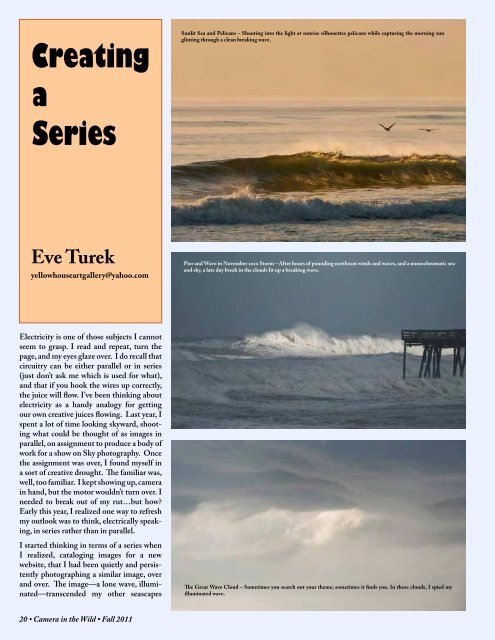CameraintheWild - Carolinas Nature Photographers Association
CameraintheWild - Carolinas Nature Photographers Association
CameraintheWild - Carolinas Nature Photographers Association
You also want an ePaper? Increase the reach of your titles
YUMPU automatically turns print PDFs into web optimized ePapers that Google loves.
Creating<br />
a<br />
Series<br />
Eve Turek<br />
yellowhouseartgallery@yahoo.com<br />
Electricity is one of those subjects I cannot<br />
seem to grasp. I read and repeat, turn the<br />
page, and my eyes glaze over. I do recall that<br />
circuitry can be either parallel or in series<br />
(just don’t ask me which is used for what),<br />
and that if you hook the wires up correctly,<br />
the juice will flow. I’ve been thinking about<br />
electricity as a handy analogy for getting<br />
our own creative juices flowing. Last year, I<br />
spent a lot of time looking skyward, shooting<br />
what could be thought of as images in<br />
parallel, on assignment to produce a body of<br />
work for a show on Sky photography. Once<br />
the assignment was over, I found myself in<br />
a sort of creative drought. The familiar was,<br />
well, too familiar. I kept showing up, camera<br />
in hand, but the motor wouldn’t turn over. I<br />
needed to break out of my rut…but how?<br />
Early this year, I realized one way to refresh<br />
my outlook was to think, electrically speaking,<br />
in series rather than in parallel.<br />
I started thinking in terms of a series when<br />
I realized, cataloging images for a new<br />
website, that I had been quietly and persistently<br />
photographing a similar image, over<br />
and over. The image—a lone wave, illuminated—transcended<br />
my other seascapes<br />
20 • Camera in the Wild • Fall 2011<br />
Sunlit Sea and Pelicans – Shooting into the light at sunrise silhouettes pelicans while capturing the morning sun<br />
glinting through a clean breaking wave.<br />
Pier and Wave in November 2010 Storm – After hours of pounding northeast winds and waves, and a monochromatic sea<br />
and sky, a late day break in the clouds lit up a breaking wave.<br />
The Great Wave Cloud – Sometimes you search out your theme; sometimes it finds you. In these clouds, I spied my<br />
illuminated wave.<br />
Frontal Boundary – As an afternoon storm front moved across the Outer Banks, bringing a brief April shower, rifts in the<br />
clouds produced this scene.<br />
Illumination – Overcast western skies near sunset produced a dull eastern seascape until the sun broke through in<br />
shafts, illuminating isolated waves.<br />
If you discover that the images have common elements but your<br />
emotional responses are very different, your series and theme<br />
might be built around those differences. Can you shoot the<br />
familiar image in a way that evokes a myriad of emotions, and<br />
let those different responses become your series?<br />
in the emotional response I had felt upon<br />
viewing the phenomena in real time and<br />
attempting to translate that emotion<br />
through photography. I’ve now shot that<br />
wave over time with normal, wide, and telephoto<br />
lenses and in both calm and stormy<br />
conditions. I even saw the same image in<br />
an early evening sky-show! I’ve lived on<br />
the Outer Banks all my adult life, within<br />
no more than four miles of the ocean. I<br />
have LOTS of ocean photographs. But<br />
this series seems different. Behind the<br />
motif I discerned a motive. Within the<br />
motive, I sense a larger purpose emerging.<br />
All of a sudden, the familiar is once again<br />
fresh. I have one photographer-friend who<br />
asks, “What is the story here?” He finds<br />
his answer in repeated shapes and forms.<br />
Another fellow CNPA member, Matt<br />
Gibson, is conscious of archetypes in a way I<br />
think of as more literary than visual, and he<br />
continues to create bodies of work around<br />
these themes.<br />
Viewers can find in my “lone wave, illuminated”<br />
series their own emotions, motifs,<br />
and stories, of course. The key point for us as<br />
photographers is to identify these emotions,<br />
motifs and stories for ourselves. In thinking<br />
about freshening your work, here are some<br />
questions you might ask yourself:<br />
Forget for a minute what catches your eye.<br />
What catches your breath? What scene or<br />
aspect of nature have you found yourself<br />
photographing again and again? Is there<br />
a motif for you in these photographs that<br />
would make them a series?<br />
What emotion predominates for you when<br />
you photograph these particular images—<br />
and do you have the same response when<br />
you view them later on your monitor? Are<br />
there other images that evoke the same<br />
emotional response? If yes, could they be<br />
combined into a series?<br />
If you discover that the images have<br />
common elements but your emotional<br />
responses are very different, your series and<br />
theme might be built around those differences.<br />
Can you shoot the familiar image in<br />
a way that evokes a myriad of emotions, and<br />
let those different responses become your<br />
series?<br />
Thinking of my emotional responses as the<br />
circuitry that connects my images within<br />
the framework of a series has given me a<br />
new way to view this place that I so love.<br />
Hopefully, the metaphor will be as helpful<br />
to some of you.<br />
<strong>Carolinas</strong>’ <strong>Nature</strong> <strong>Photographers</strong> <strong>Association</strong> • 21


